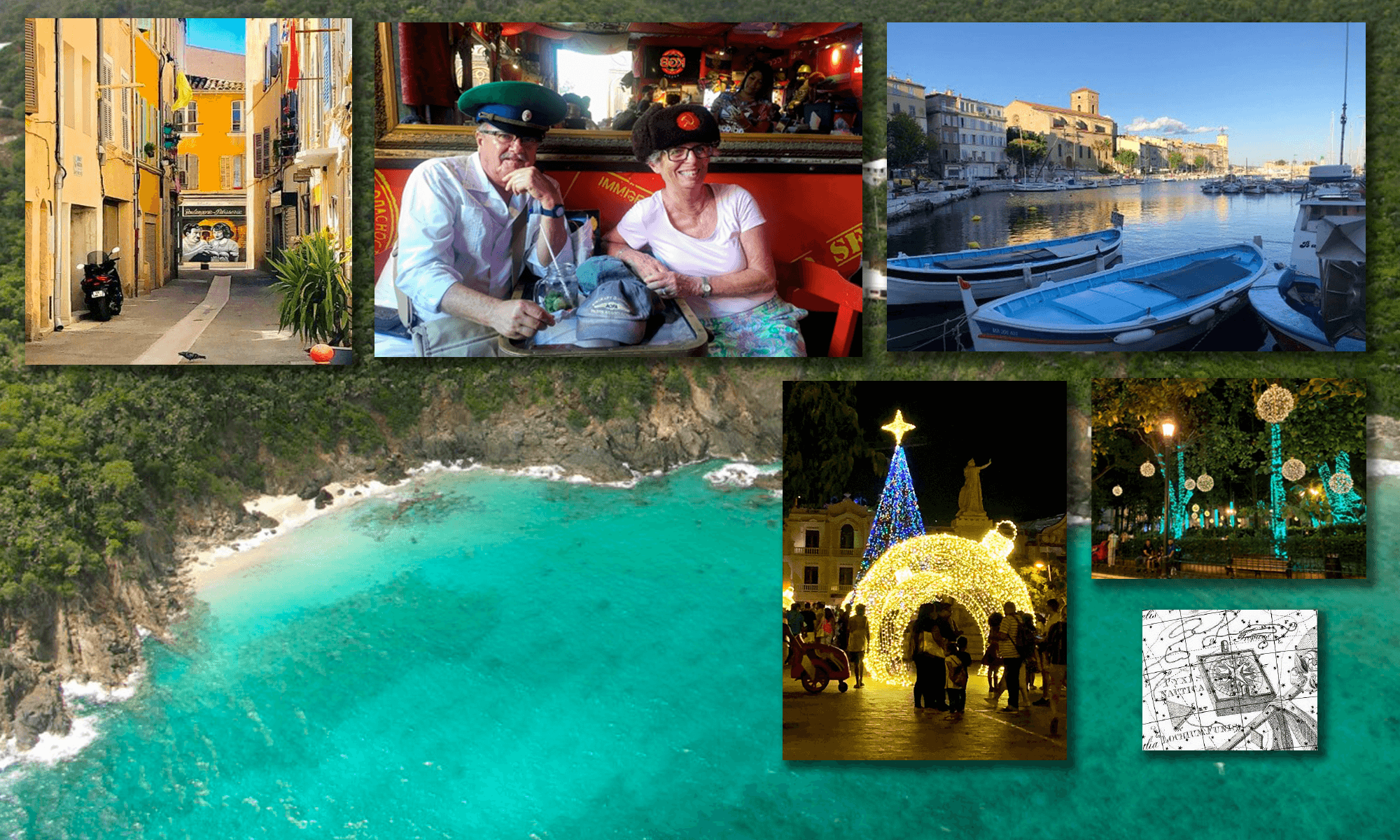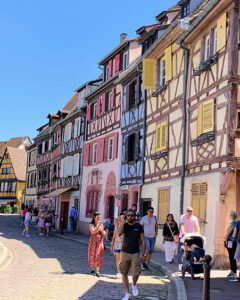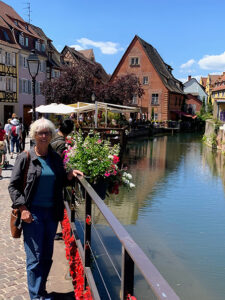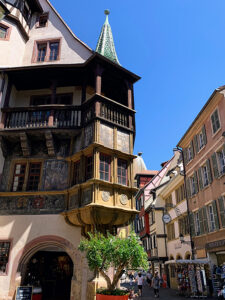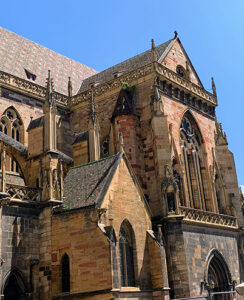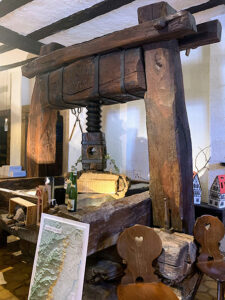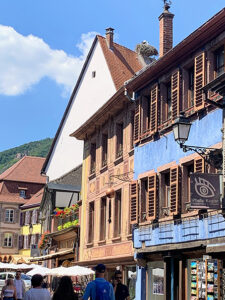COLMAR, FRANCE
Colmar is a fairy tale town just a short train ride from Strasbourg. Next morning we rode the train and then walked a short distance to the center of town. It was definitely a fairy tale town with timber-framed brightly colored buildings with a canal that runs through the center of town. It has been said that it was the inspiration for the movie “Beauty and the Beast”. We stopped in at the Visitor Center and took a map with a walking tour to follow. One of the houses is decorated for the season, such as Valentine’s Day, Easter and Christmas. Another house we passed by had watering cans hanging from the windows and most houses have bright colored flower boxes. We passed by Saint Martin Collegiate Church constructed in the 13th century and covered with red and gold stones. There are many museums in Colmar. We passed a courtyard that had a statue in front, this was the entrance to the museum dedicated to Frederic-August Bartholdi. He was the creator of the Statue of Liberty. Further on was the Pfister House with its octagonal turret and wrap-around balcony. Around each corner we discovered another “District”. The “Tanner’s District” had buildings of the tanner’s houses with roofs that had several hooks used to dry hides. The “Fishmonger’s District” along the Lauch River had the half-timbered houses of the boatmen and fishermen who put their traps in the river. Following the Rue de la Poissonniere we reached “Little Venice”. Here the houses are painted in pink, yellow and blue. Winemakers, gardeners and boatmen lived here and transported their goods to town in flat-bottomed boats, similar to gondolas. There are boat tours if you want to ride in one. The Covered Market is on the other side of the river in a brick building where traders sell fresh quality foods. It was time for a late lunch, and we enjoyed a wonderful German beef stew at Wistub La Petite Venise. From there we wandered along more meandering streets back to the train station. We almost missed the Schwendi fountain, designed by Bartholdi in 1898. It is very small and easy to miss. Lazare de Schwendi was a general under Maximilian II from 1564-1568 fighting the Turks in Hungary from where he would have brought the grape variety from Tokay. The statue was destroyed in 1940 and then rebuilt after the war.
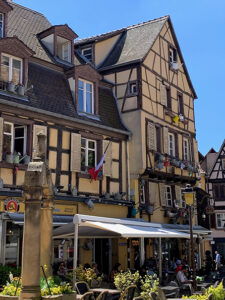 The Alsatian Wine Route is located between the Vosges Mountains in France and the Black Forest in Germany. It starts at Strasbourg and ends at Milhouse not far from Colmar, 170 km long with 70 wine growing villages with 51 Grand Crus. We took a full day tour from Viator.com which left in front of the Visitor Center in Strasbourg. Pauline was our guide driving her van and we were accompanied by a lovely couple from Bombay, India. As we were heading south Pauline explained the location of the wine route, it’s micro-climate producing great wines, mostly white wines with an occasional Pinot Noir, farming of vegetables, especially cabbage for Alsace Choucroute, and berries. Our first stop was near Barr in Heiligenstein at the Klipfel Winery. Here we got an initiation of the wines of Alsace. The wines take on the name of the grape not the vineyard. There are seven white varieties: Sylvaner, Riesling, Pinot Blanc, Muscat, Pinot Gris, Gewurztraminer, Klevener. Their wines consist of Alsace Grand Crus and Crémants. Inside the Family House is the tasting room with a large wooden table set up for tasting with pretzels. Also, there was a huge old wine press. Our next visit was in Andlau to a biodynamic vineyard. Here we were entertained by the wine maker. He showed us his organic method of growing his vines. He is lovingly called a “hippy and mad scientist” and we enjoyed his enthusiasm and tasting his wines. He produces 3 Grand Crus, but also many types, including apple juice and a wine similar to grappa. Pauline drove through many small villages, such as Itterswiller where there is a flower competition seen throughout the town. Further on she pointed out sighting a red heart or a bottle on the roof signified a home where a single woman or man lived, an earlier era dating app? She also went on to explain that if a woman left a sugar cube on the windowsill and the stork took it during the night that meant she was going to have a baby. We were on our way to Ribeauville to stop for lunch. Alsace has both French and German influences in the foods and she suggested we might want to try Tarte Flambée (Flammekueche), similar to a flat bread pizza but with a layer of crème fraiche instead of a red sauce. Frank and I wandered the village and stopped in at Le Giesberg a quaint little restaurant and ordered Tarte Flambée followed by apple strudel for dessert. Walking back to our van we spotted a stork’s nest on top of one of the building’s roofs. The stork is a symbol seen throughout Alsace. Our third and last winery of the day was in Zellenberg at
The Alsatian Wine Route is located between the Vosges Mountains in France and the Black Forest in Germany. It starts at Strasbourg and ends at Milhouse not far from Colmar, 170 km long with 70 wine growing villages with 51 Grand Crus. We took a full day tour from Viator.com which left in front of the Visitor Center in Strasbourg. Pauline was our guide driving her van and we were accompanied by a lovely couple from Bombay, India. As we were heading south Pauline explained the location of the wine route, it’s micro-climate producing great wines, mostly white wines with an occasional Pinot Noir, farming of vegetables, especially cabbage for Alsace Choucroute, and berries. Our first stop was near Barr in Heiligenstein at the Klipfel Winery. Here we got an initiation of the wines of Alsace. The wines take on the name of the grape not the vineyard. There are seven white varieties: Sylvaner, Riesling, Pinot Blanc, Muscat, Pinot Gris, Gewurztraminer, Klevener. Their wines consist of Alsace Grand Crus and Crémants. Inside the Family House is the tasting room with a large wooden table set up for tasting with pretzels. Also, there was a huge old wine press. Our next visit was in Andlau to a biodynamic vineyard. Here we were entertained by the wine maker. He showed us his organic method of growing his vines. He is lovingly called a “hippy and mad scientist” and we enjoyed his enthusiasm and tasting his wines. He produces 3 Grand Crus, but also many types, including apple juice and a wine similar to grappa. Pauline drove through many small villages, such as Itterswiller where there is a flower competition seen throughout the town. Further on she pointed out sighting a red heart or a bottle on the roof signified a home where a single woman or man lived, an earlier era dating app? She also went on to explain that if a woman left a sugar cube on the windowsill and the stork took it during the night that meant she was going to have a baby. We were on our way to Ribeauville to stop for lunch. Alsace has both French and German influences in the foods and she suggested we might want to try Tarte Flambée (Flammekueche), similar to a flat bread pizza but with a layer of crème fraiche instead of a red sauce. Frank and I wandered the village and stopped in at Le Giesberg a quaint little restaurant and ordered Tarte Flambée followed by apple strudel for dessert. Walking back to our van we spotted a stork’s nest on top of one of the building’s roofs. The stork is a symbol seen throughout Alsace. Our third and last winery of the day was in Zellenberg at 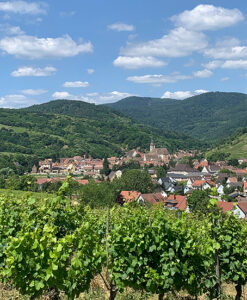 Jean Huttard winery. This is a family that is committed to sustainable environment and ecological viticulture. It was a more modern setting. Our wine tour was greatly enjoyed having visited three distinctly different wineries each with different presentations and seeing all the villages along the route. And especially learning about the wine route from our host Pauline with her little local stories about the area.
Jean Huttard winery. This is a family that is committed to sustainable environment and ecological viticulture. It was a more modern setting. Our wine tour was greatly enjoyed having visited three distinctly different wineries each with different presentations and seeing all the villages along the route. And especially learning about the wine route from our host Pauline with her little local stories about the area.
